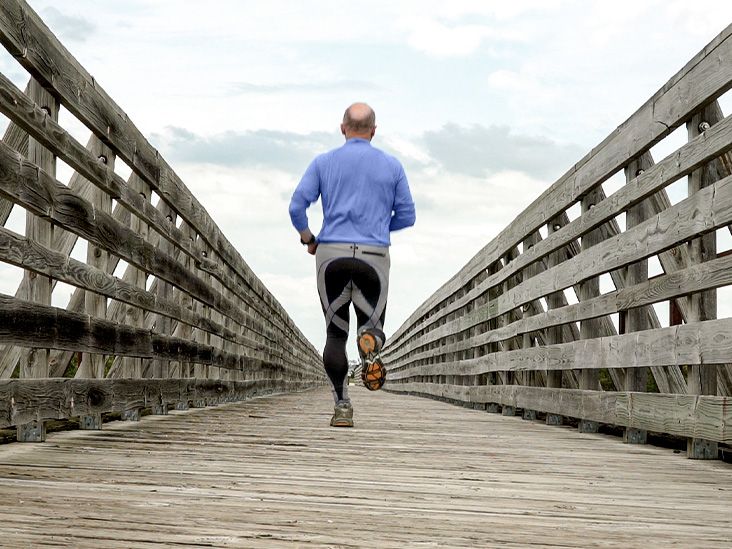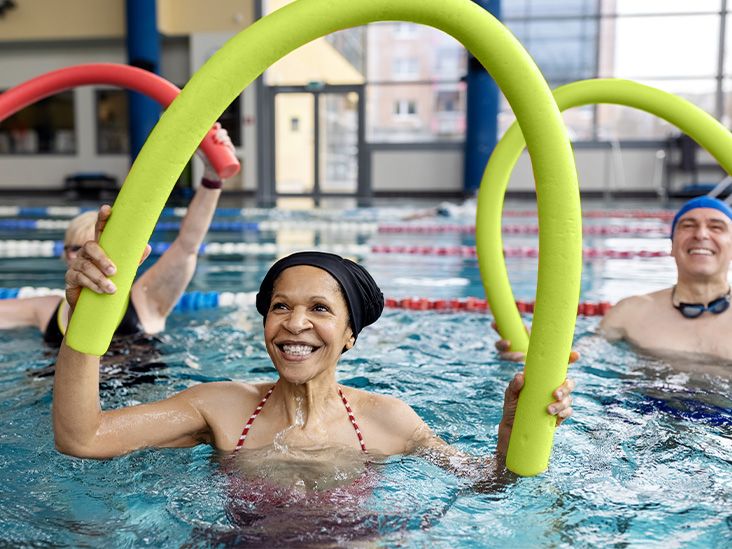You know that feeling when you get up from a chair and think, "Wow, my knees sounded like Rice Krispies this morning?" Or when you catch yourself holding onto the grocery cart just to steady yourself? I've been there too, my friend. But here's the good news getting older doesn't mean giving up on feeling great in your body.
The truth is, turning 50 and beyond brings some real physical changes, but movement can be your superpower against them. We're not talking about grueling marathon training or punishing yourself at the gym. Instead, think of simple, smart exercises that honor where you are right now while helping you build toward a stronger, more confident tomorrow.
Why 50+ Fitness Matters
Let's talk about what happens when we hit our golden years. Around age 50, our bodies naturally start slowing down in ways that can feel pretty frustrating. Muscle mass begins to decrease at a rate of about 3-5% each decade after 30, and bone density gradually declines too. Our cardiovascular system becomes less efficient, and joints that used to bounce back quickly now take longer to recover from overuse.
But here's the magic: consistent physical activity doesn't just slow these changes it can actually reverse many of them. Research shows that regular exercise after 50 can reduce your risk of heart disease, stroke, diabetes, and even certain cancers. Even more exciting, staying active helps preserve your independence well into your 70s and 80s.
Health Benefits You'll Actually Feel
Let me paint you a picture: imagine having the energy to chase your grandkids around the park without huffing and puffing by the second lap. Picture yourself climbing stairs without that familiar ache in your knees, or carrying groceries from your car without second-guessing your balance.
WebMD's research highlights how staying active combats some of the most concerning conditions that affect people after 50:
- Heart Health: Regular movement strengthens your cardiovascular system and can lower blood pressure naturally
- Bone Strength: Weight-bearing exercises actually stimulate bone growth, fighting back against osteoporosis
- Mental Clarity: Physical activity increases blood flow to the brain, potentially reducing cognitive decline
- Mood Boost: Yes, those endorphins really do make you feel more positive and energized
Studies have shown that resistance training, even something as simple as using resistance bands twice a week, can help maintain muscle mass significantly better than doing nothing at all. The key isn't perfection it's showing up consistently, even if that means starting with chair exercises while watching the morning news.
Four Essential Types of Movement
A well-rounded fitness routine isn't about becoming an Olympic athlete; it's about creating a blend that addresses the unique needs of your changing body. Think of it like preparing a nutritious meal you need different food groups to thrive, and the same applies to your exercise menu.
Aerobic Activity for Heart Health
Walking for seniors might sound basic, but hear me out it's probably the single most important exercise you can do daily. Unlike high-impact activities that might jar aging joints, walking is forgiving while still strengthening your heart. Start with 10-minute strolls around your neighborhood and gradually extend the time as it feels comfortable. Many people find they can walk longer than they expect once they start.
Swimming is another fantastic option, especially if you have joint issues. The water supports your body weight while providing gentle resistance that helps build muscle. Even three times per week can make a noticeable difference in how you feel.
Building Muscle Gently
Strength training doesn't mean heavy weights and grunting experts recommend starting with bodyweight exercises and resistance bands. Try wall push-ups instead of floor push-ups, or work with light dumbbells while sitting on a sturdy chair. Every small effort counts toward preserving the muscle you have and building new strength.
Resistance bands are particularly brilliant for home workouts because they're affordable, take up no space, and allow you to control the intensity. You can target any muscle group while doing normal activities like watching television.
Flexibility and Mobility Work
Yoga for older adults has become incredibly popular, and for good reason. Modified poses help increase flexibility, improve balance, and calm the nervous system. Even 15 minutes of stretching each morning can start your day feeling looser and more comfortable.
Tai Chi, sometimes called "meditation in motion," is another gentle approach that combines slow, flowing movements with deep breathing. Many community centers offer classes specifically designed for seniors, making it social and stress-free.
Balance and Coordination Training
Falling is a legitimate concern after 50, but regular balance exercises can significantly reduce that risk. Simple practices like standing on one foot while brushing your teeth, or practicing heel-to-toe walking down a hallway, strengthen the systems that keep you steady on your feet.
Functional movements like practicing standing up from a chair without using your hands help prepare your body for real-life activities. You'll be amazed at how much more confident these simple exercises make you feel during everyday tasks.
Starting Small and Staying Consistent
If you haven't exercised regularly for a while, jumping into intense routines often leads to injury or burnout and that's exactly what we want to avoid. The most important thing is developing consistency, even with tiny steps.
Beginner-Friendly Entry Points
Chair exercises are wonderfully underrated. While sitting, you can work your legs with seated marches, strengthen your arms with overhead reaches, and even do modified tricep dips using the chair edge for support. These exercises provide real muscle engagement without the risk of falling or overexertion.
Walking doesn't have to be elaborate either. A daily stroll around your neighborhood counts, especially if you're consistent. Start with whatever feels manageable perhaps walking to the mailbox each day, then gradually increasing the distance as you build endurance.
Wall push-ups are perfect for rebuilding upper body strength without the intimidation factor of floor work. Simply place your hands against the wall at shoulder height and perform push-up motions. As your strength improves, you might eventually feel ready for incline push-ups using a sturdy table.
Shrey, a popular fitness instructor who focuses on anti-aging movements, demonstrates simple yet effective exercises that specifically target leg strength and grip two areas where many people notice significant decline after 50. These movements prove that powerful results can come from minimal equipment and maximum attention to proper form.
Key Strength Exercises to Try
Want a specific starting point? Here are five fundamental exercises that physical therapists commonly recommend for people 50 and beyond:
- Forearm Plank: Start on your knees if needed, keeping your body in a straight line from knees to head. Hold for 10-30 seconds, gradually increasing as it becomes easier.
- Bodyweight Squats: Use a chair behind you for support. Sit back and down as if you're about to sit, then stand up again. This movement mimics real-life sitting and standing, making it incredibly functional.
- Tricep Dips: Sit on a sturdy chair, place hands on the seat beside your hips, slide your bottom off the chair, and bend your elbows to lower your body down before pushing back up.
- Bicep Curls with Resistance Bands: Step on the band with both feet, grab the handles, and curl upward. The resistance provides continuous tension unlike traditional weights.
- Downward Dog Splits to Knee Drive: This multi-movement exercise improves flexibility, balance, and core strength simultaneously.
Remember, you don't have to master all of these immediately. Pick one or two that appeal to you most and practice them consistently for a few weeks before adding new ones. Progress lives in consistency, not perfection.
A Sample Weekly Plan
Putting it all together, here's a practical structure that many people find achievable:
| Day | Focus Area | Example Exercises |
|---|---|---|
| Monday | Strength | Squats, Chair Dips, Bicep Curls |
| Tuesday | Cardio + Stretch | Brisk walk + light stretching |
| Wednesday | Yoga/Tai Chi | Full body stretches, breathing, calm flow |
| Thursday | Core + Balance | Forearm plank, heel raises |
| Friday | Full Body Circuit | Mix low-impact cardio, resistance, and balance |
This routine spreads different types of activity throughout the week, preventing boredom and giving your body variety. Some days you'll have more energy than others, and that's completely normal. Listen to your body and adjust accordingly.
Mistakes to Watch For
In my experience coaching people through senior fitness transitions, certain patterns tend to cause unnecessary trouble. Let's address them upfront so you can avoid common pitfalls:
- Doing too much too fast: Eager beginners often overestimate what their bodies can handle, leading to soreness that discourages future activity
- Ignoring discomfort: While some muscle fatigue is normal, sharp or persistent joint pain is worth investigating
- Skip warm-up: Taking three minutes to prepare your muscles and joints prevents injury and improves performance
- Balance neglect: Incorporating balance exercises is crucial, not optional, for safety
Pay attention to warning signs like chest pain during exercise, severe dizziness, or joint pain that doesn't improve within 24 hours. These symptoms merit consultation with a healthcare provider before continuing.
Finding Your Perfect Frequency
CDC guidelines recommend aiming for 150 minutes of moderate-intensity activity each week, plus muscle-strengthening exercises at least twice. Translated into real life, that might look like 30 minutes of walking five days per week, with two of those days including strength-focused exercises.
But honestly? Any movement is better than none. If you can manage 10 minutes of gentle stretching every morning, you're already making a positive impact. The goal is sustainable consistency, not heroic efforts that burn you out.
The beauty of senior fitness routines lies in their adaptability. Your body today might require different approaches than your body next month. Honor those changes rather than fighting against them. Some days you'll have more energy; others, you'll appreciate the gentle comfort of seated stretches.
Building Confidence Through Movement
When I work with clients over 50, the transformation I witness isn't just physical it's deeply emotional too. People who start incorporating regular movement into their lives often report improved sleep, better mood, and increased confidence in tackling daily activities.
Your journey with exercise after 50 isn't about recapturing your 20-year-old body (which probably wasn't as perfect as you remember anyway). It's about becoming the strongest, most resilient version of yourself at this stage of life. And here's the secret: small, consistent actions compound over time in remarkable ways.
The best exercises for over 50 are the ones you actually enjoy doing and can realistically maintain. Maybe that's dancing to your favorite playlist every evening, or taking a tai chi class at the community center where you make new friends along the way.
Your Next Steps Forward
Reading about fitness is completely different from actually moving your body. So what's one tiny action you can take today?
- Try a 10-minute morning stretch routine while your coffee brews
- Take the stairs instead of the elevator for one flight this week
- Sign up for a local walking group that meets twice monthly
- Do seated exercises during TV commercial breaks
Remember, the goal isn't to become the person who runs marathons at 70 it's to become the person who never stops believing that better days lie ahead. Every step, stretch, and strengthening movement you do today contributes to the quality of your life tomorrow.
You've already taken the first brave step by caring enough about your wellbeing to explore options. That matters more than any perfect workout ever could. Trust your body to guide you, celebrate small victories, and never underestimate the power of gentle, consistent progress.
Your strongest, most vibrant decades may still be waiting just around the corner. All you need to do is take that next small step today.
FAQs
What are the best exercises for people over 50?
Walking, swimming, resistance band workouts, yoga, and bodyweight exercises like squats and planks are ideal for building strength and mobility after 50.
How often should I exercise after 50?
Aim for at least 150 minutes of moderate activity per week, plus two days of strength training, but start slow and stay consistent.
Can I build muscle after 50?
Yes, regular resistance exercises using bands, light weights, or bodyweight can help maintain and even increase muscle mass as you age.
What are safe exercises for seniors with joint pain?
Low-impact options like swimming, tai chi, chair exercises, and gentle stretching are easier on the joints and still highly beneficial.
How do I start exercising if I’m out of shape?
Begin with short, simple routines like seated marches, daily walks, or wall push-ups. Consistency matters more than intensity at first.
Disclaimer: This article is for informational purposes only and does not constitute medical advice. Always consult with a healthcare professional before starting any new treatment regimen.
Related Coverage
Learn how AARP Medicare Advantage plans work, including benefits, costs, and how they compare to other Medicare options....
Find the right Nebraska Medicare plans that fit your health needs and budget. Compare options and make informed decisions....
Finding Medicare in Virginia that fits your needs doesn't have to be confusing. Get clear guidance and local resources....
Medicare fall prevention services help seniors reduce risks and maintain independence. Learn how Medicare covers wellness visits, therapy, and safety equipment....
Aquatic exercises for seniors offer low-impact workouts that boost mobility, strength, and mental well-being. Start your water fitness journey today....
Learn about fresh wasabi's intense flavor and health benefits and discover where to buy the top authentic wasabi paste to perfectly complement sushi....
Medicare funeral coverage isn't included in standard plans. Find out what options exist to help with end-of-life costs....
Get clear info on Medicare New Hampshire options, from Advantage plans to prescription coverage. Find the right fit for your needs....
Get clarity on how Medicare handles preexisting conditions and waiting periods. Know your coverage options and make informed decisions....
Gentle exercises for over 50 help build strength, balance, and energy. Start moving today with safe, effective routines....









